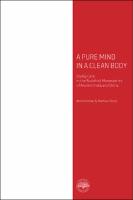A Pure Mind in a Clean Body
Bodily Care in the Buddhist Monasteries of Ancient India and China
| dc.contributor.author | Heirman, Ann | |
| dc.contributor.author | Torck, Mathieu | |
| dc.date.accessioned | 2014-02-09 00:00:00 | |
| dc.date.accessioned | 2020-04-01T14:48:39Z | |
| dc.date.available | 2020-04-01T14:48:39Z | |
| dc.date.issued | 2012 | |
| dc.identifier | 466590 | |
| dc.identifier | OCN: 908083587 | en_US |
| dc.identifier.uri | http://library.oapen.org/handle/20.500.12657/33493 | |
| dc.description.abstract | Buddhist monasteries, in both Ancient India and China, have played a crucial social role, for religious as well as for lay people. They rightfully attract the attention of many scholars, discussing historical backgrounds, institutional networks, or influential masters. Still, some aspects of monastic life have not yet received the attention they deserve. This book therefore aims to study some of the most essential, but often overlooked, issues of Buddhist life: namely, practices and objects of bodily care. For monastic authors, bodily care primarily involves bathing, washing, cleaning, shaving and trimming the nails, activities of everyday life that are performed by lay people and monastics alike. In this sense, they are all highly recognizable and, while structuring monastic life, equally provide a potential bridge between two worlds that are constantly interacting with each other: monastic people and their lay followers. Bodily practices might be viewed as relatively simple and elementary, but it is exactly through their triviality that they give us a clear insight into the structure and development of Buddhist monasteries. Over time, Buddhist monks and nuns have, through their painstaking effort into regulating bodily care, defined the identity of the Buddhist saṃgha, overtly displaying it to the laity. | |
| dc.language | English | |
| dc.subject.classification | thema EDItEUR::1 Place qualifiers::1F Asia::1FK South Asia (Indian sub-continent)::1FKA India | en_US |
| dc.subject.classification | thema EDItEUR::1 Place qualifiers::1F Asia::1FP East Asia, Far East::1FPC China | en_US |
| dc.subject.classification | thema EDItEUR::2 Language qualifiers::2A Indo-European languages::2AC Germanic and Scandinavian languages::2ACB English | en_US |
| dc.subject.classification | thema EDItEUR::3 Time period qualifiers::3K CE period up to c 1500::3KH c 500 to c 1000 CE | en_US |
| dc.subject.classification | thema EDItEUR::5 Interest qualifiers::5A Interest age / level::5AX For adult emergent readers | en_US |
| dc.subject.classification | thema EDItEUR::Q Philosophy and Religion::QR Religion and beliefs::QRF Buddhism::QRFP Buddhist life and practice | en_US |
| dc.subject.other | india | |
| dc.subject.other | bodily care | |
| dc.subject.other | buddhism | |
| dc.subject.other | china | |
| dc.subject.other | Chinese language | |
| dc.subject.other | History of China | |
| dc.subject.other | Monastery | |
| dc.subject.other | Monk | |
| dc.subject.other | Sangha | |
| dc.subject.other | Vinaya | |
| dc.title | A Pure Mind in a Clean Body | |
| dc.title.alternative | Bodily Care in the Buddhist Monasteries of Ancient India and China | |
| dc.type | book | |
| oapen.identifier.doi | 10.26530/OAPEN_466590 | |
| oapen.relation.isPublishedBy | 76cb5309-2a30-44e7-bc8c-7892cd1fa38c | |
| oapen.relation.isbn | 9789038220147 | |
| oapen.pages | 194 | |
| oapen.remark.public | Relevant Wikipedia pages: Buddhism - https://en.wikipedia.org/wiki/Buddhism; China - https://en.wikipedia.org/wiki/China; Chinese language - https://en.wikipedia.org/wiki/Chinese_language; History of China - https://en.wikipedia.org/wiki/History_of_China; Monastery - https://en.wikipedia.org/wiki/Monastery; Monk - https://en.wikipedia.org/wiki/Monk; Sangha - https://en.wikipedia.org/wiki/Sangha; Vinaya - https://en.wikipedia.org/wiki/Vinaya | |
| oapen.identifier.ocn | 908083587 |

